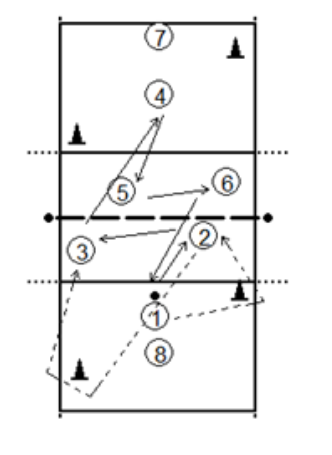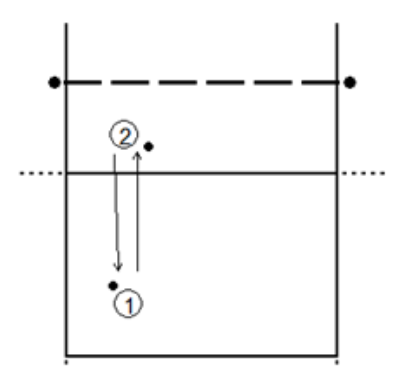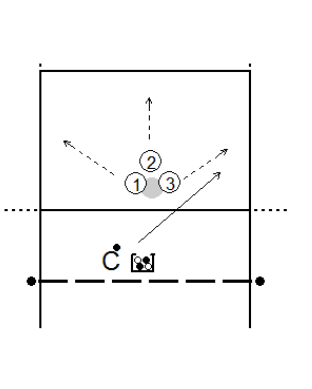Volleyball drills
Tens
- play overhead to each other and
- when you have played each time then touch the pawn.
1 pass on 2,
2 set-up on 3,
3 BH on 4 -
4 pass on 5
5 set-up on 6,
6 BH on 8
etc. Turn over: - 1 runs around the pawn to the position of 2.
1 moves around the pawn to the position of 2
2 moves around the pawn to position 3
3 to the other side to the position of 4, etc.

1 and 2 both have a ball
1 plays underhand to 2
2 rolls his ball over the ground to 1
etc. VARIATION: pass overhead and roll 2nd ball

- 1, 2, and 3 start in the middle
- C bounces the ball and the players move to their defensive positions.
- C attacks one of the defenders.
- after the defence, set-up and 3 meter attack
- after 5 times a new 3

- A line-up of six players stand in the field.
- On the other side stands the trainer, included if necessary.
- Three players stand at the net with 1-2 balls and one server stands (this can also be the trainer).
- The first ball is served and handled by the 6 players.
- Where the attack is played, the person standing with the two balls at the net, throws the ball back over the net very quickly.
- In this way the attacking cover is trained.
- From this cover, all attackers must of course return as quickly as possible to give support.
- A short run is important.
- You will therefore be training a lot of blocking without actually blocking
- Keep on blocking until the net players have run out of balls, until it is not safe or until they simply cannot play anymore.
- Rotate through a position every so often so that side-out is trained on every position.
- After throwing the ball, the net players should look back to make sure that the previous ball doesn't secretly roll back under the net.
- Two numbers facing each other
- with two balls
- one ball overhead
- the other ball rolling on the ground
After each part, a short rest and then through again. Parts with * need a bench, 2 to 4 persons per bench
- Part 1:
- 30 step-ups* (getting on/off the bench)
- 15 push-ups* (feet on the bench)
- Part 2:
- 30 east-west step-ups* (right foot on bench left foot next to it â€" left foot on it right foot next to it)
- 10 squats jumps (going through the knees and jumping as high as possible when stretching)
- Part 3:
- 20 side shuffles over 4 meters
- 10 slit-squat jump (jump and go through 1 knee, other knee each time)
- Part 4:
- 30 step-ups* (stepping on/off the bench)
- 15 push-ups* (feet on the bench)
- playmaker, attackers, 1 ball
- SV only plays the ball high outside
- Attacker hits and retrieves own ball
- SV only plays the ball fairly flat outside
- Attacker hits and retrieves own ball
- SV only plays the ball far outside
- attacker hits and fetches own ball
- SV only plays the ball high midfield
- attacker hits the ball and fetches own ball
- SV only plays the ball fairly flat at mid
- attacker hits the fast ball and fetches own ball
- SV plays the ball just before the 3-metre line
- attacker hits the ball and picks up own ball
- SV only plays the ball high outside
Part 1
- The players are divided into two equal teams.
- The balls are distributed equally on both sides of the net.
- The aim is to have as few balls on your own side as possible.
The way to pass the balls / course of play:
- Roll
- Throwing (overhand, underhand, one arm)
- Storage (underhand, overhand)
Part 2
- The trainer places a ball on the half way line.
- On either side of the net, a line of players stands at the back line.
- At the signal of the trainer they run to the ball, whoever has it may keep it.
Which team collects the most balls?
Variations:
- The players on both sides of the net are numbered (so that 2 players of the 2 different teams have the same number)
- Storm at sea: if your number is called, you must try to get the ball as quickly as possible and get back behind your line (= point + safety for the opponent).
- If you are tapped by your opponent when you have the ball in your hands, you have to drop the ball (you can pick it up immediately afterwards and continue playing).
- The trainer puts several balls on the middle line and everyone plays against everyone else and tries to collect as many balls as possible. (Several times, not as many balls as players, can also be played with a time limit, ...)
Purpose of exercise:
To teach the body that you should never give up.
Exercise Explanation:
- In volleyball, we are so conditioned that after the ball hits the ground, everyone stops playing.
- Because of this, you sometimes get players to lower their heads before the ball hits the ground.
- Through this very fun game form, you teach your body to just keep going after the bounce.
- You will see that your body gets used to never giving up.
- You are playing a game.
- When the ball hits the ground, you go after it, while you, as coach, count how many times it hits the ground before the ball is finally played up.
- Suppose Team A has got the ball up after 6 bounces, then they have to pass, set-up and attack 6 times.
- Points are awarded when the ball no longer bounces but rolls and when the ball has bounced a total of 20 times.
- So trainer, you will have to count!
- The whole team sits against the wall
- The first one runs from the wall to the net and back and then sits against the wall again,
- Then the next player can run.
- They are not allowed to stop until the whole team has walked back and forth once.
- Afterwards the same exercise but with planks instead of sitting against the wall.
Goal of the exercise:
- Defending everything and getting the ball high inside the three-meter line
Explanation of the exercise:
- This is a nice defensive drill to get into after the warm-up.
- The trainer stands inside the 3-metre line.
- There is a line of players at the back line.
- The trainer throws, pokes or hits balls in all directions.
- The person in front of the row has to defend the ball, in such a way that the ball ends up as close to the trainer as possible within the 3-metre line.
- If this doesn't happen, that person goes to jail at the ball pit.
- But if the person behind the one with the bad defending ball, manages to get the volleyball right to you as trainer, the first one is bought free and does not have to go to prison.
- When people are in prison, they may only re-enter the field when the others have defended the ball twice without errors within the 3-metre line.
- The players will help each other, even if one player makes a mistake that could be made better by another.
- Tip: when using a high ball pit, the trainer will have the balls on the grip quicker.








